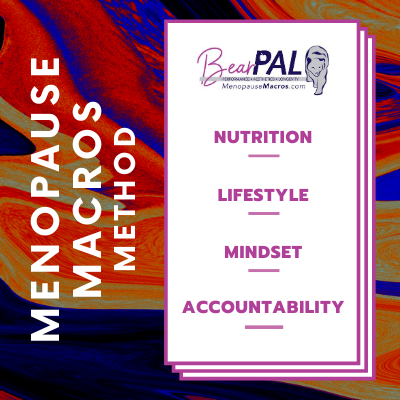Insulin resistance, metabolic syndrome, high blood sugar/glucose, and hyperinsulinemia are the same, but the bottom line is that we have lost metabolic flexibility. Menopause insulin resistance is a problem many of us struggle with.
Metabolic Flexibility
We can lose our metabolic flexibility – the ability to burn different fuels – mainly fats and carbs – at different times. Menopause and insulin sensitivity issues often go hand in hand. As estrogen wanes, we lose the ability to burn fats/fatty acids, and we stay awash in carbohydrates and glucose. It is challenging to release, mobilize, and oxidize (or burn) our body fat – especially for peri- to postmenopausal women. From perimenopause on, our estrogen wanes, causing us to lose our insulin sensitivity and the ability to properly utilize carbohydrates.
Why can’t I eat carbs like I used to?
Our cells want to burn fatty acids preferentially as we age. We become beta-oxidizers. If we are constantly flooded in glucose from a high carbohydrate intake, we may store the excess glucose by converting it to body fat when our muscles and liver have processed and stored all they can handle. We can only hold so much glucose in our blood and glycogen in our liver and muscles. Our muscles cannot release glycogen to other cells in the body; they can only use it for themselves. Our liver can release glycogen slowly over time, where our cells can use it as glucose again. Unfortunately, we usually eat again before the liver is depleted of glycogen stores, so we run on those carbs instead of reaching into fat stores. When we are awash in glucose and stored glycogen, we won’t release the fat, and then our bellies grow, and our energy drops. We become insulin resistant.
Insulin Resistance
We can eat ourselves into a hole with highly processed foods consisting of mainly sugars and fats and overeating carbs. If we are constantly spiking our blood sugar without stabilizing, we produce more and more insulin to reduce the glucose in our blood. Our cells can then become insulin resistant, causing our bodies to produce more and more insulin to get the glucose into our cells. This problem can lie silent for years before responding with high glucose or insulin readings from a doctor’s visit.
Insulin is like a gatekeeper that holds energy in reserve for us, so you don’t want zero insulin. Some insulin is a good thing. Type 1 diabetics have a genetic dysfunction where they do not produce insulin, but type 2 diabetics have produced so much insulin they are either resistant to it or have stopped producing it, so we give them insulin to manage their blood sugar. What sense does that make? We have high insulin, so we give the body more insulin to force that blood glucose into those resistant cells? But I digress.
Insulin holds our energy stores back, numbs the cells against taking up glucose, and keeps fat stores from being released and utilized. When insulin is high, our bodies preferentially burn glucose and tap glycogen stores before anything else, including dietary and body fats. Excess glucose floating around in our systems after the storage is topped off converts to fatty acids. The fatty acids are stored as body fat. We have body fat in places we never had before, such as belly fat.
What causes the loss of metabolic flexibility?
There are numerous causes of insulin resistance, but here are four primary ones for peri- to postmenopausal women:
- Elevated cortisol levels – from stress (all forms), medications, sleep deprivation.
- Excessive inflammation – systemic, food intolerances/sensitivities, gut pathogens, autoimmune conditions.
- High blood sugar – high loads of refined sugars and starches, high ultra-processed food intake.
- Overconsumption of linoleic acid/Omega-6 fatty acids – soy, corn, canola, or other seed oils; poor quality meats and dairy.
Does measuring help?
Glucose meters can measure glucose spikes from foods we eat, but who wants to measure their glucose every time they eat and try and keep track of what spikes, how long it lasts, etc.? A continuous glucose monitor is an option, but it can be pricey. Fasting glucose is often included in annual physicals, but that is only a snapshot. The Hemoglobin A1C test is a little better since it is a three-month rolling view of your glucose. More and more doctors are ordering fasting insulin tests as well. It all comes down to the individual’s reaction to different foods and food combinations. But even without measurements, you can improve your insulin resistance.
What can I do?
Suppose we allow the glucose to run down and the glycogen to be used up before another meal. In that case, we can turn to fat to fuel our cells, and our liver will convert some fatty acids into ketones which are water-soluble fat bits that our brain can use instead of glucose. Over time, we can get this machinery running again, releasing fat from storage and transporting it to cells, where it can be used in the mitochondria to produce energy.
We can build back up our ability to burn fats through beta-oxidation in our cells with fasting, time-restricted eating, or reducing carbohydrate overload. Contrary to popular belief, you don’t have to eat copious amounts of fat to get into ketosis or become “fat adapted” to get your metabolic flexibility back. Nor do you have to eliminate carbs!
We believe we have to go to extremes – eat no fat, eat no carbs! Neither of these may be the answer for you personally. Here are some things to start with:
Avoid meals and snacks of only carbs and fats together
Besides milk and some nuts, this combo is not found in nature (think bears and squirrels getting fat on acorns). Milk is produced by mammals, including humans, to fatten up their babies to survive. Milk provides other nutrients, but other fat/carb combos can get you, including donuts, French fries, chips, pastries, cake, etc. Avoid these by basing your meals and snacks on protein/fats, protein/carbs, or protein/fats/carbs.
Reduce your consumption of processed foods
Foods are often engineered to trick your brain into eating more than you intend. They often contain lots of stuff our body doesn’t need or like to process. If something is low fat, they probably added sugar to it to get you to eat it, and if something is low carb, they probably added fat to it to get you to eat it. Stop falling into their trap. Avoid ultra-processed engineered foods.
Remove sugars
Look for where it is hidden on labels. Please don’t eat it by itself; eat it with protein (protein and carb combo). Added sugars are usually without nutrients. Whole fruits provide fiber and other nutrients that juices do not, and the blood sugar spike from whole fruit can be dampened with some protein.
Avoid seed and vegetable oils
Use coconut, avocado, MCT, and olive oil instead. Read the labels on salad dressings, mayos, sauces, crackers, or anything with oil. We are overloaded with vegetable and seed oils in processed foods. These are not heart-healthy despite the claims.
Prioritize protein and healthy fats
Don’t fall into the whole avoid-meat-and-only-eat-plants thing unless you have a moral/ethical reason. Most Americans do not get enough protein, and as we age, we need more. If you use plant protein sources, make sure you get complete proteins with each meal and snack.
Should I go Keto?
For extreme cases where you have tried different macro mixes and are not losing weight, a temporary Keto or extremely low carb diet might help get you off the sugar/carb train. For some, weaning down on carbs and only using them around workouts and in the evenings is all they need. Others might have to go full Keto to regain the ability to burn dietary and body fat as fuels rather than depending on glucose from carbs. On the flip side, too long on very low carb could reduce your metabolic flexibility in the opposite direction – meaning we lose the ability to process carbohydrates correctly. This is still a debated topic, but the goal is to increase your metabolic flexibility and do so on a diet that you can maintain.
Should I do high carb/low fat?
But what about low fat, high carb diets? Yes, this can work, especially if there is a focus on plant-based carbohydrates, meaning veggies, not sugars or excessive grains. However, this may not reduce insulin overload, and it is not a satiating way to eat, so calories may have to be severely restricted. Unfortunately, this is our current MyPlate food advisory algorithm, and it isn’t working out for anyone other than the grain industry. We are sicker and fatter than ever before, and there are a lot of theories out there about why this is.
We are individuals
Last summer, I dabbled in Keto for four months and took some flack. If you had asked me two years ago if I would have tried it, I would have laughed. Just like I laughed about getting a minivan when I had kids. I’m always willing to grow and change, though. And covi left some time for experimentation. I learned a few things. What worked for us five years ago doesn’t work now. Why? We may never know, but we know you need a diet that fits you. We have different histories, preferences, lifestyles, microbiomes, emotions, stressors, etc. One way will not work for everyone. But we have the tools to figure it out.
Metabolic Typing
Metabolic typing is a tool in the toolbox for figuring out your macro mix. We have genetic traits that we have been carried down for eons. Metabolic typing takes our genetics, epigenetics, lifestyle, and other factors into account and helps us determine the right macro mix. We can then tweak that to find what makes us feel energized and healthy. Our diet is one of the most influential factors in our health, so starting with whole foods in the right mix and amount leads to better health, weight loss, muscle gain, healing, and improving our metabolic flexibility.
It is my job to help you figure out what works for you!





